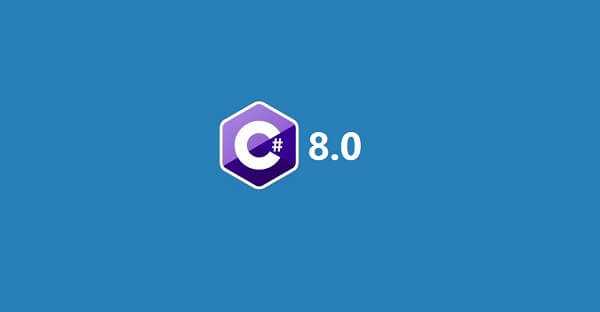C# 8.0的计划特性
2021-04-07 03:26
标签:tar await 其他 lex 代码段 streams ima dev use 虽然现在C# 7才发布不久,并且新的版本和特性还在增加中,但是C# 8.0已经为大家公开了一些未来可能出现的新特性。 *注:以下特性只是计划,可能在将来的正式版本会有一些差异 该特性其实本来计划在C#7.x中就引入,但是却被推迟到了下一个版本中。目的是为了避免引用为null的时候而导致的错误。 其核心思想是允许变量类型定义指定是否可以为它们分配空值: 此时当申明可为nullable的对象赋值为null的时候,编译器就不会提示警告。 records是一个新的语法糖,它简化了原来创建简单类的过程,通过一条语句就可以创建出一个标准的C# 类。 例如下面的代码: 它相对于原来的写法是: 上面的代码段可以看出,该类具有只读属性和初始化它们的构造函数。它实现值的比较,并且重写了GetHashCode,以便在基于哈希的集合中使用,如Dictionary 和 Hashtable。 同时我们还看到在倒数第二个方法是一个解构的方法,它允许我们将Record所创建的对象进行解构为一个元组(关于解构的特性,可以参加C#7.0的特性) 最后的一个With方法可以供我们创建一个不同属性值的Sword副本对象。 当然,对于With的方法,C# 也提供了一个语法糖写法: 在以往的C# 语法中,我们都知道一个Interface只能够申明方法体,却不能对其进行实现: 按照以往的写法,我们一般是尝试写一些抽象类来作为替代实现: 但在C# 8.0中可能引入接口的方法实现功能。 C# 目前是已经支持了迭代器( iterators ) 和 异步方法。在C#8.0中打算结合现有的两者,推出异步的迭代器,它将基于异步的 IEnumerable 和 IEnumerator 接口: 此外,使用异步迭代器还需要IDisposable接口的异步版本: 接下来,在使用的时候,可能看上去就像下面这样: 当然,这个写法对我们C#的开发人员来说可能还不是太眼熟,因为在传统的迭代器写法上,我们已经习惯了Foreach的写法,因此对于异步迭代器来说,它也会存在对应的一个foreach版本,就如同下面这样: 这个特性可能相对来说就比较有趣了,它允许我们使用简短的语法来定义一个区间值,比如: 这样就产生了一个表示已声明范围的结构: 在实际的应用过程中,我们可以这样来使用它: 这个特性看上去果然非常的good。 对泛型特性的支持将为需要类型作为参数的属性提供更好的语法。目前,只能使用以下语法将类型传递给特性: 当有了泛型特性之后,我们可以尝试这样做: 在C# 7.x中引入了default 默认值和解构的概念。在C# 8中将实现两者的共同作用。 要为C#7中的元组的所有成员分配默认值,必须使用元组赋值语法: 通过支持解构语法中的默认文字,以下语法也可以实现相同的功能: 在C#5中,引入了CallerMemberName, CallerFilePath and CallerLineNumber特性,方便我们能够获取到有关调用方法的一些信息。 就像CallerMemberName在INotifyPropertyChanged中的应用,对于WPF开发的童鞋就在熟悉不过了: 在C#8中可能会引入一个叫做CallerArgumentExpression的特性,它捕获调用方法中的参数: 这可能也将成为将来常用的一个新特性,它将更加简化在申明时候的类型推断。 比如以往我们申明一个对象是这个样子的: 但是在C#8中,将简化成这样: Over: 当然距离C#8真是发布可能还要等一段时间,期间可能也会增加一些其他的特性,真正的体验效果还是一起期待8.0的发布吧 C# 8.0的计划特性 标签:tar await 其他 lex 代码段 streams ima dev use 原文地址:https://www.cnblogs.com/uoyo/p/9119062.html
1.Nullable Reference Types
1 IWeapon? canBeNull;
2 IWeapon cantBeNull;
canBeNull = null; // no warning
cantBeNull = null; // warning
cantBeNull = canBeNull; // warning
canBeNull.Repair(); // warning
cantBeNull.Repair(); // no warning
if (canBeNull != null) {
cantBeNull.Repair(); // no warning
}
2.Records
public class Sword(int Damage, int Durability);
public class Sword : IEquatable
var (damage, durability) = sword;
var (damage, durability) = sword;
var strongerSword = sword with { Damage = 8 };
3.Default Interface Methods
interface ISample
{
void M1(); // allowed
void M2() => Console.WriteLine("ISample.M2"); // not allowed
}
abstract class SampleBase
{
public abstract void M1();
public void M2() => Console.WriteLine("SampleBase.M2");
}
4.Asynchronous Streams
public interface IAsyncEnumerable
public interface IAsyncDisposable
{
Task DisposeAsync();
}
var enumerator = enumerable.GetAsyncEnumerator();
try
{
while (await enumerator.WaitForNextAsync())
{
while (true)
{
Use(enumerator.Current);
}
}
}
finally
{
await enumerator.DisposeAsync();
}
foreach await (var item in enumerable)
{
Use(item);
}
async IAsyncEnumerable
5.Ranges
var range = 1..5;
struct Range : IEnumerable
Span
foreach (var index in min..max)
{
// process values
}
switch (value)
{
case 1..5:
// value in range
break;
}
6.Generic Attributes
public class TypedAttribute : Attribute
{
public TypedAttribute(Type type)
{
// ...
}
}
public class TypedAttribute
public TypedAttribute(T value)
{
// ...
}
7.Default Literal in Deconstruction
(int x, int y) = (default, default);
(int x, int y) = default;
8.Caller Argument Expression
class ViewModel : INotifyPropertyChanged
{
public event PropertyChangedEventHandler PropertyChanged;
private void OnPropertyChanged([CallerMemberName] string propertyName = null)
{
PropertyChanged?.Invoke(this, new PropertyChangedEventArgs(propertyName));
}
private int property;
public int Property
{
get { return property; }
set
{
if (value != property)
{
property = value;
OnPropertyChanged();
}
}
}
}
public Validate(int[] array, [CallerArgumentExpression("array")] string arrayExpression = null)
{
if (array == null)
{
throw new ArgumentNullException(nameof(array), $"{arrayExpression} was null.");
}
if (array.Length == 0)
{
throw new ArgumentException($"{arrayExpression} was empty.", nameof(array));
}
}
9.Target-typed new Expression
Dictionary
class DictionaryWrapper
{
private Dictionary